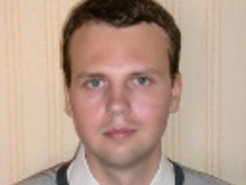Alumni 2013
Milica Micic (9.1.) - Paul Boley (5.2.) - Gustavo Dopcke (6.2.) - Ronald Laesker (8.2.) - Chia-Chun Lu (17.4.) - Jochen Tackenberg (22.4.) - Mathias Jaeger (2.5.) - Ervin Kafexhiu (3.7.) - Anton Prosekin (3.7.) - Paola Pinella (5.7.) - Meiert Grootes (18.7.) - Federica Capranico (24.7.) - Faviola Molina (25.7.) - Alessandra Grassi (25.7.) - Aram Giagi-Saravani (26.7.) - Stephan Henke (16.10.) - Maren Mohler-Fischer (21.10.) - Dario Colombo (30.10.) - Karsten Dittrich (30.10.) - Fredrik Windmark (5.11.) - Philipp Merkel (6.11.) - Yu-Yen Chang (17.12.) - Lei Liu (19.12.)
Lei Liu (China) - 19.12.2013

A Multi-Phase Chemodynamic Galaxy Formation Model (thesis pdf, 10 MB)
In this thesis, I present my PhD work: a multi-phase chemodynamic galaxy formation and evolution model. The model is aimed at treating the dynamics of stars, molecular (cold) clouds, and hot/warm diffuse gas individually and allowing for mass, momentum, and energy exchange between them in a self-consistent way, so as to overcome the difficulties of a single-phase description. I introduce the detailed implementation of physical processes in the model including gravity, gas dynamics, heat conduction, cooling, star formation and stellar feedback. A dwarf galaxy model is evolved for 1 Gyr. The corresponding star formation rate decreases from 1 Msol/Year to 0.1 Msol/Year. The cloud mass distribution follows a power law with a slope of -2.3. The discrepancies of chemical abundance between hot/warm and cold phase are reproduced. As an extension to the classical multi-phase model, I introduce a transition process such that hot/warm gas can collapse to cold clouds, which solves the problem of cold clouds' initial mass fraction and distribution in the multi-phase simulation. This process is proven to be more suitable for low mass systems. Also I implement an individual star formation model, in which individual stars are created analytically inside a molecular cloud with a stellar mass distribution given by a specific initial mass function (IMF). This model reproduces the life cycle of interstellar medium in a galactic scale simulation and realizes the process of star cluster formation inside one molecular cloud. The multi-phase code is parallelized with MPI and shows good scaling relations. GPUs are used to accelerate the most time consuming parts (gravity, SPH and neighbour search), which results in a speedup of one oder of magnitude for the whole program.
Supervisor: Rainer Spurzem (ARI)
Yu-Yen Chang (Taiwan) - 17.12.2013

Galaxy Shapes through Cosmic Time - Intrinsic Structure of Early-type Galaxies at High Redshift (thesis pdf, 9 MB)
In this thesis, we measure for the first time the projected shapes of large samples of distant early-type galaxies in deep near-infrared surveys from the ground and with the Hubble Space Telescope, and reconstruct their intrinsic, three-dimensional shape distribution assuming random viewing angles. We find that the most massive early-type galaxies are roundest at all redshifts 0 < z < 2.5, indicating that at any cosmic time mergers dominate the growth of the most massive galaxies. However, early-type galaxies were on average more disk-like at earlier times, indicating that star formation in their progenitors occurred in disks, and that merging is the dominant evolutionary channel after star formation ceases. Together with the recent finding that typical early-type galaxy sizes increase dramatically between z ~ 2 and the present, the increased `roundness' suggests that classical elliptical galaxies emerge through gradual merging and accretion of satellites. Moreover, the observed increase in number density over the same time span suggests that new early-type galaxies form continuously, also at late cosmic times. Our findings suggest that these newly formed early types are generally disk-like at all redshifts, and subsequently become larger and rounder through merging. In addition, we provide a low-redshift benchmark for high-redshift galaxy studies, by deriving new stellar mass and star formation rate estimates for nearly a million galaxies drawn from Sloan Digital Sky Survey spectroscopic sample. Our novel approach combines photometry from multiple surveys that span a large range in wavelength (from 0.4 to 22 micron), and uses the latest modeling techniques to consistently incorporate the effects of extinction and emission by dust. We use these new properties to investigate the nature of the bimodality of star formation activity in the galaxy population.
Supervisors: Arjen van der Wel, Hans-Walter Rix (MPIA)
Dario Colombo (Italy) - 30.10.2013

Gas organization in M51 - The impact of spiral arm dynamics on Giant Molecular Cloud properties (thesis pdf, 50 MB)
Recent observations have shown that star formation is correlated with the molecular phase of the interstellar medium. Molecular gas tends to organize itself into large and roughly self-gravitating entities called Giant Molecular Clouds (GMCs). These objects should, therefore, play a key role in controlling star formation and defining its modes. However, their physical properties, formation and evolution mechanisms are still poorly understood - especially in spiral galaxies. The new PdBI Arcsecond Whirlpool Survey (PAWS) offers, for the first time, the possibility to study the molecular gas distribution in a grand-design spiral galaxy dominated by dynamical phenomena. The aim of this thesis is to evaluate the importance of galactic environments for the gas organization. Via a thorough analysis of the gas kinematics I study the structure of M51’s gravitational potential and spiral arm streaming motions. This analysis provides several insights on the differing nature of the molecular and atomic phase of the interstellar medium. I also find evidence for a kinematic m = 3 mode that explains the asymmetry of the spiral arms. To investigate the effect of the dynamical environment on the molecular gas I have generated the largest extragalactic GMC catalog to date using an automatic algorithm that accounts for the observational biases. Differences in the cloud properties suggest that environments, and in particular dynamical effects, strongly influence the organization of the gas in spiral galaxies and provide a way to discriminate between the various mechanisms of cloud formation and evolution that have been proposed in the literature.
Supervisor: Eva Schinnerer (MPIA)
Maren Mohler-Fischer (Germany) - 21.10.2013

Search for extrasolar planets around young stars in the presence of stellar activity (thesis pdf, 14 MB)
Planets form in circumstellar disks around newly born stars. The timescales of planet formation and migration remain poorly constrained and are a matter of ongoing debate. The disk dispersal timescale, which sets a limit to the duration of planet formation, was derived from infrared surveys to be less than 10Myr. In order to test the predicted planet formation time scales described in current theories, it is important to find planets in the age range of 1 to 100Myrs. In the same manner, non-detections can help to understand the current theories. However, the number of discoveries is still very small due to the challenging task to analyze RV signals contaminated by the high stellar activity. Within this thesis, I performed a systematic radial velocity (RV) search for planets around 21 young targets with ages between ~3 and ~400Myr and spectral types between F6 and M0. In order to account for the strong stellar activity, I analyzed the stellar spectra in terms of a variety of activity indicators, analyzing both single spectral lines and the RV cross-correlation function. For three targets, a strong radial velocity signal could be identified, which was not induced by measurement sampling. Due to the analysis of available photometric data and activity indicators, it was possible to exhibit stellar activity patterns such as cool stellar spots as origin of the signal. The simulation with a spot program allowed to reconstruct possible spot scenarios that could have caused the detected RV variability. The challenge of the conformation of a transit planet with follow-up observations in presence of stellar activity is shown in the discussion of HATS-2b, a transiting extrasolar planet orbiting a K-type star showing starspot activity. Furthermore, the discussion of a possible companion around the young eruptive star EX Lupi is part of this thesis. The detailed RV and activity analyses show the challenging task to disentangle RV signals caused by a possible companions and by stellar activity. Although no planet could be identified in the RV search around 21 young stars, it can in summary be stated that the detailed analyses in this thesis allow to put constraints on further RV surveys looking for exoplanets around young stars. This includes not only the sample size and target selection but also the observations and data analysis methods.
Supervisor: Thomas Henning (MPIA)
Stephan Henke (Germany) - 16.10.2013

Modellierung der thermischen Entwicklung von Asteroiden unter Beruecksichtigung geochronologischer Daten aus Meteoriten (thesis pdf, 4 MB)
A numerical model is developed for the thermal evolution of asteroids and is applied to parent bodies of a meteorite class known as ordinary chondrites. This model includes sintering, as well as the influence of 60Fe as a heat source, additional to 26Al. The model is fitted to empirically determined cooling ages of H chondrites using a genetical algorithm under the assumption of an onion shell model to determine the parameters of the H chondrite parent body. Furthermore, the influence of parent body growth on the thermal evolution is examined. The results demonstrate that porous planetesimals of a few km in size are able to develop central temperatures high enough for melting. For the most part, the results of the fit to the H chondrite cooling ages show that the onion shell model excellently reproduces the thermal evolution history of all H chondrites used. The reconstructed properties of the parent body are comparable to those of models of others. According to the fitting results, 60Fe does not play a role in the thermal evolution of the H chondrite parent body. The examination of different accretion times yields that only rapid growth is compatible with the thermochronology of the H chondrites. Also, the influence of preheated building blocks is low for the case of short accretion times. As a result, the usage of the instantaneous accretion approximation in future models is justified.
Supervisor: Hans-Peter Gail (ITA)
Philipp Merkel (Germany) - 06.11.2013
Different aspects of the interplay between light and the large-scale structure of the Universe (thesis pdf, 4 MB)
The main subject of this thesis is the influence of intrinsic alignments on weak lensing measurements. One possible source of intrinsic alignments are correlations in the angular momenta of neighbouring galaxies. Employing an improved ansatz for the angular momentum correlation function I show that the typical correlation length of Milky Way-sized haloes is about 1 Mpc/h which is slightly smaller than earlier work in this field suggested. Establishing the constitutive formalism to describe intrinsic alignments consistently in the framework of 3d cosmic shear I compute the resulting covariance matrices of different alignment types. For a Eucild-like survey it turns out that intrinsic alignments are more than one order of magnitude smaller than the lensing signal. In addition the parameter estimation bias in a two-dimensional non-tomographic weak lensing measurement is computed. The matter density Omega_m and the normalization of the linear matter power spectrum sigma_8 are most severely biased if intrinsic alignments are described by an angular momentum based alignment model. In the second part of my thesis I address secondary anisotropies of the cosmic microwave background: weak gravitational lensing and the nonlinear integrated Sachs-Wolfe (iSW) effect. The characteristic imprint of lensing can be used to reconstruct the lensing potential power spectrum. I show how this reconstruction is biased in the presence of primordial non-Gaussianities. For current values of f_NL, however, the bias is completely negligible on all but the largest angular scales. Finally, a novel analytical approach for the computation of the nonlinear iSW effect valid in the translinear regime is presented. It allows to identify two distinct contributions: the change of the gravitational self-energy density of the large-scale structure with (conformal) time and the Birkinshaw-Gull effect.
Supervisor: Bjoern-Malte Schaefer (ARI/ITA)
Fredrik Windmark (Sweden) - 05.11.2013

Planetesimal formation by dust coagulation (thesis pdf, 5 MB)
When the protostellar nebula collapses to form a star, some of the gas and dust is left in the form of a protoplanetary disk. Exactly how the subsequent formation of planetesimals proceeds is still not fully understood, but the coagulation of the dust is believed to play a vital role. One of the main problems with this picture is that a number of barriers have been identified, at which bouncing, fragmentation and radial drift prevent the formation of large bodies. We have investigated via theoretical models how large dust grains can grow in the presence of these barriers. This was done by examining some of the many assumptions that are generally used in the dust evolution modeling. We implemented a realistic model for the outcome of dust collisions, and we also studied the effect of velocity distributions and particle clumping, as well as the fate of large dust grains that drift inwards towards the star. In this process, we identified a new channel for planetesimal formation, and describe the initial steps towards an inside-out formation model where we give a prediction of the size and spatial distribution of the first generation of planetesimals.
Supervisor: Kees Dullemond (ITA)
Karsten Dittrich (Germany) - 30.10.2013

Numerical simulations of planetesimal formation in protoplanetary disks (thesis pdf, 7 MB)
In the first step of planet formation micrometer-sized dust grains grow in a protoplanetary disk through collisional sticking. This growth becomes inefficient at several centimeters up to meters in size, depending on the distance to the star. The resulting agglomerates are concentrated by turbulence in the disk up to densities at which they fragment through self-gravity to 100km-sized planetesimals. In my PhD thesis I simulate the concentration of dust particles in the turbulent gas flow of protoplanetary disks. Here I treat the gas as a fluid and solve the magnetohydrodynamic equations with the Pencil code. Dust particles are simulated as non-collisional point particles, decoupled from the grid. At first I test the particle representation of the Pencil code by comparing a Rayleigh-Taylor instability (RTI) simulation of a dust-laden fluid with a classical two-layer fluid RTI simulation. Additionally I simulate the sedimentation of a dust clump in a fluid which can be compared with experiments. Further I study zonal flows and the resulting long-lived axisymmetric pressure bumps that are created in magnetorotational instability simulations. Zonal flows are described by annuli of gas rotating faster or slower than the pressure-supported Keplerian rotation. They are created by temporal and spacial variances in the magnetic pressure. In a convergence study I measured a typical radial size of 5 to 7 vertical gas pressure scale heights with a life time of up to 50 local orbits (T_{orb} = 2\pi\Omega^{-1}). Particles get captured by these pressure bumps. For dust particles with a friction time \tau_f \ge 0.1\Omega^{-1} I found concentrations that are some hundred times higher than initially. Larger particles (\tau_f \ge 0.5 \Omega^{-1}) reach densities 10,000 times higher than their initial densities, sufficient to trigger secondary instabilities such as the streaming instability and gravitational collapse. I study the streaming instability in a zonal flow environment in simulations of higher resolution including the back-reaction drag from particles to the gas. These simulations show that the axisymmetric pressure bumps can accumulate enough particles to trigger the streaming instability, even with small particles (\tau_f = 0.1 \Omega^{-1}). Allowing for self-gravity dust clumps form, yet they are not stable against tidal forces. This is due to the insufficient resolution here. For my last project I studied the final collapse of a spherical dust cloud with a much higher resolution than in the above simulations. In this study I investigate a dust cloud with an initial density ranging from Roche density \rho\Roche down to 10^{-3}\rho_Roche$. Dust spheres with 0.1\rho_Roche, like I typically get from large scale simulations, fragment to a swarm of bound objects with a size distribution that is comparable to the observed size distribution of asteroids.
Supervisor: Hubert Klahr (MPIA)
Federica Capranico (Italy) - 24.07.2013

Statistics of Intrinsic alignments and Weak Lensing (thesis pdf, 14 MB)
The content of this work is two-fold. In the first part we present a study on the contamination of the intrinsic alignments to weak lensing measurements in the future survey Euclid. On the grounds of the tidal torque theory, we have adopted from the literature two related prescriptions for modeling the intrinsic alignment signal and computed for both the resulting biases in the cosmological parameters. We find a slight discrepancy among the two models, which both significantly (up to > 3 sigma) contaminate the estimates for Omega_m and sigma_8. The other parameters h, ns and w appear less affected. In the second part we present results based on an innovative statistical approach, the extreme value statistics. We investigate up to which level the primordial non-Gaussianities parameters fNL and gNL inherited by the bi- and trispectra of the weak lensing convergence can be constrained by the most extreme values of the convergence field. We find constraints of the order of 102 for fNL and 105 for gNL if individual extreme values are considered, therefore sadly showing only a relatively weak constraining power.
Supervisor: Bjoern-Malte Schaefer (ARI)
Aram Giahi-Saravani (Germany) - 26.07.2013

Statistics of Intrinsic alignments and Weak Lensing (thesis pdf, 4 MB)
First, changes in galaxy ellipticity statistics induced by weak gravitational lensing are studied. Ellipticity correlations are altered by lensing deflection on multipoles l > 1000 by ~ 5% for the ellipticity E-modes and by ~ 30% for the B-modes, while a shallower survey would exhibit larger changes. The E/B-mode conversion is analyzed, the possibility of measuring correlations between different multipoles, induced by homogeneity breaking, is discussed. Although correlations generated by weak gravitational shear dominate, the shifting effect is significant on small angular scales, causing a number of interesting phenomena possibly observable by future surveys. Second subject of this work is the time evolution of intrinsic correlations of galaxy ellipticities due to peculiar galactic motion. The magnitude and scale on which peculiar motions affect the ellipticity correlation is studied. Correlations are decreased on large multipoles l> 1000, up to 10 per cent in the E-mode and up to 60 per cent in the B-mode spectrum at l> 3000. E/B-mode conversion is present but small. Observational significance is concluded for larger scales for surveys at lower redshifts. Another aspect of weak lensing statistics is explored in the context of Bayesian model comparison. Frequentist and Bayesian statistics are contrasted in the context of inflationary non-Gaussianity models.
Supervisor: Bjoern-Malte Schaefer (ARI)
Alessandra Grassi (Italy) - 25.07.2013

Baryon acoustic oscillations and primordial non-Gaussianities with weak lensing (thesis pdf, 13 MB)
This work introduces two investigations on possible new weak lensing applications. In the first part, I present a study on the possibility of detecting baryon acoustic oscillations by means of 3d weak lensing (3dWL). Basing our analysis on a Fisher matrix approach, we quantify the uncertainty on inferring the amplitude of the power spectrum wiggles with 3dWL. Ultimately, we find that surveys like Euclid and DES should be able to detect, respectively, the first four and three oscillations, with errors reaching the 1% or 10% of the amplitude for the first two wiggles in the case of Euclid. The second part of this work focuses on the study of primordial non-Gaussianities with a classical weak lensing approach. We study inflationary bi- and trispectra, the strentgh of their signals, and the consequences of fitting data with a wrong type of bispectrum on the inferred on fNL. We conclude that contraints on fNL are not competitive with the ones from CMB, but nonetheless valuable in case of a scale-dependent fNL. Lastly, we quantify lensing ability to test the Suyama-Yamaguchi inequality, and ascertain that Euclid could give evidence in favour or against the inequality for large non-Gaussianity values (tauNL > 10^5 or fNL > 10^2).
Supervisor: Bjoern-Malte Schaefer (ARI)
Faviola Molina Hernandez (Venezuela) - 25.07.2013

Baryon acoustic oscillations and primordial non-Gaussianities with weak lensing (thesis pdf, 4 MB)
Understanding molecular cloud formation is a major challenge in modern astrophysics. Although the improvements on computational power and novel astronomical instrumentation have allowed us to reach unprecedented accuracy, there are still many open questions. One key issue which helps us to understand the physics behind this problem is the correct comparison between numerical models and observations. Usually, the 12CO(J=1-0) emission is considered to be a good tracer of the temperatures and structure of molecular clouds. However, it has been found that it may provide a biased picture of clouds, at best. In this thesis, we analyze a large set of numerical simulations with the aim of making direct comparison with observations. Using a 3D magneto-hydrodynamical simulation including time-dependent chemistry, we find that most of the CO is located at number densities greater than 100 /cm^3 and kinetic temperatures (T_K) below 40 K, regardless of the mean number density (n_0), metallicity (Z) and UV radiation field strength (UV). Radiative transfer calculations are performed to analyze the 12CO(J=1-0) rotational transition line intensity that comes out of the cloud. We then calculate the excitation temperature (T_ex) considering theoretical and observational approaches and find that the gas is mostly sub-thermally excited, indicating that T_ex represents a lower limit of T_K. T_ex is used for estimating the CO column density (N_CO). Considering the full position-position-velocity spectrum for inferring T_ex, instead of the usual way of using the maximum of the intensity along the line of sight, improves the estimates of N_CO by \sim 30%. Besides, when a single Milky-Way like CO-to-H_2 conversion factor is assumed, the total inferred mass of H_2 is underestimated by a factor which typically increases from \sim 0.1 to 1, as the product$n_0 x Z decreases, and/or UV becomes stronger. Moreover, we propose density variance--Mach number relations for supersonic, magnetized, turbulent gas, including an isothermal and non-isothermal equation of state. These analytical relations reproduce satisfactorily the measurements made on numerical simulations. We find that the magnetic field strength scales with density in a relationship of the kind B \propto \rho^\alpha with 0\leq \alpha< 1/2.
Supervisor: Ralf Klessen (ITA)
Paola Pinilla (Colombia) - 05.07.2013

Testing models of dust evolution in protoplanetary disk with millimeter observations (thesis pdf, 22 MB)
The first steps of planet formation imply that dust grows from interstellar-like particles to planetesimals. Diferent physical processes play an important role in the dust evolution and its ability to coagulate and fragment, such as: radial drift, settling to the midplane and turbulent mixing. Observational evidences have shown that millimeter sized particles survive in the outer regions of protoplanetary disks in spite of the fragmentation destructive collisions and rapid inward migration of dust bodies, which are theoretically expected. The main goal of my thesis is to compare the state-of-the-art of gas and dust evolution models with current millimeter observations and look for the most favorable scenarios to have a good agreement between the two. Different cases have been explored: typical disks around Sun-like stars, lowmass disks as the ones around Brown Dwarfs and disk with inner gaps or holes known as transition disks. This work therefore brings new theoretical constraints to the planetesimal formation in young circumstellar disks, in direct link with the available observations.
Supervisor: Cornelis Dullemond (ITA)
Meiert Willem Grootes (Netherlands) - 18.07.2013

The Evolution of Spiral Galaxies in the Group Environment (thesis pdf, 11 MB)
Although the process by which galaxies obtain the gas needed for star-formation is amongst the most fundamental processes related to the formation of baryonic structure in the universe, there is very little in the way of empirical evidence with which to constrain theoretical models. In particular, the postulated environmental dependencies of this process, although widely modeled, remain largely unconstrained. In this work, I present the first detailed, quantitative analysis of the environmental effects on the process of gas-fueling in which the relevant effects of the galaxy - intergalactic medium interaction have been isolated from other potential environmental in uences. In the context of this analysis, a new robust method for selecting morphologically defined samples of galaxies by photometric proxies is developed, as well a powerful new method for correcting the UV/optical emission of samples of spiral galaxies for the effects of attenuation by dust located in their disks. Combining these tools with the data from the GAMA survey, in particular the galaxy group catalog, I present a detailed analysis of the environmental dependencies of gas-fueling. The results obtained require a fundamental re-evaluation of the assumptions concerning the fueling of satellite galaxies and the effects of active galactic nuclei.
Supervisor: Richard Tuffs (MPIK)
Anton Prosekin (Russia) - 03.07.2013

Propagation and radiation of ultrarelativistic particles in magnetic fields in different astrophysical environments (thesis pdf, 2 MB)
The thesis work presents the results of theoretical studies of different scenarios for the propagation and the radiation of ultrarelativistic particles depending on the environment determined by the magnetic and low energy radiation fields. First, using the analytical solution of Boltzmann equation in the small-angle approximation, we have accurately calculated the angular, energy, and time distributions of the ultrahigh energy protons, gamma rays produced by synchrotron radiation of secondary electrons and positrons, and secondary neutrinos from the source of cosmic rays embedded in the magnetized environment of the level of B ~ 10^(−9) G. The second part considers the scenario explaining TeV gamma radiation from distant blazars by secondary gamma rays produced by cosmic rays along the line of sight in the weak magnetic field of the level of B ~ 10^(−15) G. We have studied the possibility of detection of TeV radiation from blazars with redshifts greater than z = 1. Finally, the last chapter of the work is addressed to the radiation of charged particles in the extremely strong magnetic fields of compact objects such as pulsar and black hole. We have studied the synchrotron and curvature radiation regimes and transition between them showing the strong sensitivity of radiation spectra on the pitch angle.
Supervisor: Felix Aharonian (MPIK)
Ervin Kafexhiu (Albania) - 03.07.2013

Radiation signatures of nuclear reactions in very hot astrophysical plasmas (thesis pdf, 5 MB)
The importance of nuclear reactions in low-density astrophysical plasmas with ion temperatures kT>1 MeV has been recognized for more than thirty years. However, the lack of comprehensive data banks of relevant nuclear reactions and the limited computational power did not allow detailed theoretical studies. In this thesis, using the publicly available code TALYS, I have built a large nuclear reaction network relevant for temperatures exceeding 1MeV. It contains about 270 nuclear species and include the calculation of gamma-ray emissivity due to different nuclear reactions. The pi0-mesons production are also included. An approach to calculate the gamma-ray spectra through p + p to pi0 channel for an arbitrary proton distribution is also proposed. The nuclear network is applied to two-temperature accretion disk models the so-called Advection Dominated Accretion Flows (ADAF) and Shapiro-Lightman-Eardly (SLE). The gamma-rays emissivity are calculated for a wide parameter space including initial chemical composition. For a 10 solar mass black hole, both models can produce nuclear gamma-ray lines luminosities as large as L_N ~ 10^{34} erg/s. SLE is not an effective source of pi0 photons, whereas ADAF luminosity can be as large as L_pi ~ 10^{35} erg/s. ADAF regime is hot enough to evaporate neutrons. They can reach the companion star atmosphere and initiate secondary nuclear reactions.
Supervisor: Felix Aharonian (MPIK)
Mathias Jaeger (Austria) - 02.05.2013

Evolution of galaxies studied by the COMBO-17+4 survey (thesis pdf, 9MB)
In this thesis the evolution of galaxies at redshift z < 2 was analyzed, using the COMBO-17+4 (Classifying Objects by Medium-Band Observations) survey. This survey used optical as well as near-infrared data from three different fields of view with a total area of 0.625 square degree. On the basis of an H band selected catalog the photometric redshifts, rest-frame colors and masses of 42,134 galaxies to a limiting magnitude of H = 21.7 mag were calculated. Using the color bimodality in (U280 −V) the galaxies were divided in a red (passive) and a blue (active) population, which were analyzed separately. The results verify the existence of a bimodality up to a redshift of z = 1.6. Further the evolution of the luminosity function for both galaxy populations was analyzed in ten redshift bins. In both populations a significant decrease in the characteristic magnitude M∗B from z = 2 to z = 0.2 was measured. Moreover the number density of red galaxies showed a slight increase during this time, whereas the number density of blue galaxies was decreasing. An analysis of the mass function showed a constant value of the characteristic mass for both populations and an increase of the mass density for red galaxies from z = 2 to z = 0.2.
Supervisor: Klaus Meisenheimer (MPIA)
Chia-Chun Lu (Taiwan) - 17.04.2013

An advanced direction reconstruction technique and application to the observation with H.E.S.S. (thesis pdf, 18MB)
The High Energy Stereoscopic system (H.E.S.S.) is an array of five imaging atmospheric Cerenkov telescopes which aims at exploring the high energy non-thermal processes in the universe via detecting very high-energy (VHE) gamma rays. In this work, an advanced direction reconstruction algorithm which yields better point spread function (PSF) and sensitivity is developed to cope with the complex morphology analysis in the Large Magellanic Cloud (LMC) region. LMC is a satellite galaxy of Milky Way at the distance of 48 kpc. The relatively short distance makes it a good extra-galactic laboratory for astronomical observation. The H.E.S.S. observation focuses on the three targets hosted in this region: the young supernova remnant SN1987a, the pulsar wind nebula N 157B, and the superbubble 30Dor C. The VHE flux of SN 1987a is predicted at the detectable level for H.E.S.S. but no significant detection is found in the current dataset. An upper limit on the gamma-ray flux is derived for this target. The pulsar wind nebular N 157B is detected, and the spectrum and other physical quantities are derived. The gamma-ray flux shows that it is the most-energetic-ever observed pulsar wind nebula. At the vicinity of N 157B, we find extra gamma-ray excess towards the direction of 30Dor C. The existance of this source is established by detailed morphology studies and its connection to 30Dor C is discussed.
Supervisor: Werner Hofmann (MPIK)
Jochen Tackenberg (Germany) - 22.04.2013

Early stages of high-mass star formation (thesis pdf, 16MB)
This thesis is dedicated to the formation of high-mass stars. In particular, we are interested in the initial conditions that allow massive stars to form. Therefore, we first examine the very initial stage of massive star formation. Based on a statistical survey study over 20 deg2 from mid-infrared to sub-millimeter wavelengths, we show that dense and massive starless clumps exist. Assuming that they will form stellar clusters instead of single objects, we estimate their lifetime to be between 15 kyr and 60 kyr. In order to understand such short lifetimes, we investigate the large-scale dynamical structure of high-mass star-forming regions. Using N2H+ observations we find smooth largescale velocity gradients in a number of filaments, which are consistent with gas flowing along the filament. Analyzing HCO+ and H13CO+ spectra, we find global supersonic gas infall onto a few regions. To understand whether the dynamics of an expanding Hii region can trigger star formation, we select a starless clump located on the rim of a bubble which is infrared-dark up to 160 μm. In a multi-wavelengths approach we search for imprints of the bubble on the gas. While an expanding Hii region might favor the formation of high-mass stars, we find no evidence that it triggers the collapse. In summary, this thesis emphasizes that high-mass star formation is a fast and dynamic process.
Supervisor: Henrik Beuther (MPIA)
Ronald Läsker (Germany) - 08.02.2013

Supermassive black holes and their host galaxies - fundamental scaling relations (thesis pdf, 128MB)
The research presented in this thesis aims at improving the characterization of the scaling relations of the masses of central Supermassive Black Holes with bulge and total luminosities of their host galaxies. These scaling relations are significant for our understanding of the evolution of galaxies and the origins of Supermassive Black Holes. As part of this investigation, 35 galaxies with known central Black Hole mass were observed at near-infrared wavelengths. The obtained images were subjected to a thorough photometric analysis, which led to reliable bulge and total luminosities. As a result, it could be shown that the slope of the correlation between central Black Hole masses and bulge luminosities was previously overestimated. Further, it was found that the correlation with total luminosity is equally tight as the correlation with bulge luminosity. A linear regression method was devolped that enables extraction of more detailed information about the cosmic scatter in the scaling relations. In the last part of this thesis, a Black Hole mass was determined by means of dynamical modeling. The measured mass far exceeds the prediction from current scaling relations, thereby putting the universality of the scaling relations in question and principally opening up opportunities to better understand the physics of galaxy and Black Hole formation.
Supervisor: Glenn van de Ven (MPIA)
Paul Boley (USA) - 05.02.2013

High-resolution studies of circumstellar material around massive young stellar objects (thesis pdf, 3MB)
In this thesis, I investigate the nature of circumstellar material around massive young stellar objects (MYSOs). I make extensive use of spatially-resolved observations, and examine spatial structure at scales ranging from tens of astronomical units up to nearly a parsec. In the first of three scientific studies presented in this thesis, I present the results of a survey to observe MYSO candidates with the Very Large Telescope Interferometer at mid-infrared wavelengths, using the MIDI instrument. I consider the properties of this sample of 20 objects as a whole, and address the sources individually. In the second study, I focus on the well-known MYSO IRAS 13481-6124. By combining interferometric data from both near- and mid-infrared wavelengths, I derive a temperature profile for the circumstellar disk around this object, which I discuss in the context of theoretical disk models. In the third study, I examine the high-luminosity source AFGL 4176 at wavelengths of 1 mkm 1 mm. I construct one-dimensional radiative transfer models of the envelope, and interpret the interferometric observations in terms of a parameterized disk model. The observations and results presented in this thesis will be of use to future studies of MYSOs, both theoretical and observational, and provide an important groundwork for observations of such objects with the next generation of interferometric instruments at the Very Large Telescope.
Supervisor: Thomas Henning (MPIA)
Gustavo Dopcke (Brasil) - 06.02.2013

On the physics of the low metallicity IMF (thesis pdf, 3MB)
A fundamental question in the context of structure formation concerns the transition from massive primordial stars to Population I/II stars with typical masses of less than 1 M_Sol, and in particular the physical mechanisms inducing this transition. The purpose of this work is to study the physical mechanisms that shape the stellar IMF at the early stages of the Universe. With this aim, we perform a set of eight hydrodynamic simulations that include sink particles representing contracting protostars. Evidence for fragmentation was found in all cases, and hence we conclude that there is no critical metallicity below which fragmentation is impossible. Nevertheless, there is a clear change in the characteristic mass of the clouds at Z = 10^-4 Z_Sol. Moreover, we develop a model for the stellar IMF, which accounts for the evolution of simulated clusters. With that, we can recover results from hydrodynamic simulations, and also observations of the Orion Nebulae Cluster. Finally, we find that the resultant stellar mass distribution is highly dependent on the characteristic mass of the cluster, and the mode of mass accretion.
Supervisor: Ralf Klessen (ITA)
Milica Micic (Serbia) - 09.01.2013

Molecular cloud formation with self-consistent thermal and chemical treatment of the gas (thesis pdf, 5MB)
Understanding physical and chemical processes that guide the formation and evolution of giant molecular clouds (GMCs) has important implications for the formation of stars. GMCs dominantly consist of molecular hydrogen, but there are more than 200 chemical species of various combinations of carbon, nitrogen and oxygen atoms. Together, these species control the cooling ability with the thermal and dynamical evolution of the gas cloud. In order to overcome the restrictions encountered by most previous models of molecular cloud formation due to the complexity of chemical reaction networks and its inclusion in hydrodynamical codes, we have implemented detailed treatment of atomic/molecular cooling and hydrogen chemistry into state-of-art high resolution hydrodynamical simulations. The main focus of our study is on the influence that choosing between different cooling functions and turbulent driving has on the formation and evolution of molecular gas. In that manner, we study the influence of the nature of the turbulence on the formation of molecular hydrogen by examining both solenoidal (divergence-free) and compressive (curl-free) turbulent driving. The obtained results we use to test a simple prescription suggested by Gnedin et al. (2009) for modelling the influence of unresolved density fluctuations on the H2 formation rate in largescale simulations of the ISM. We also investigate the properties of the dense clumps formed within our model of the molecular cloud formation in converging flows and directly compare the results obtained using the simple, parametrized cooling function introduced by Koyama & Inutsuka (2002) and used by a number of converging flows studies with the results of the detailed calculation of the non-equilibrium chemistry and thermal balance of the gas. Finally, we study C I and CO emission from molecular clouds in comparison to their column densities and the total column density, as we look for the way to trace the structure of the cloud.
Supervisor: Ralf Klessen (ITA)





















